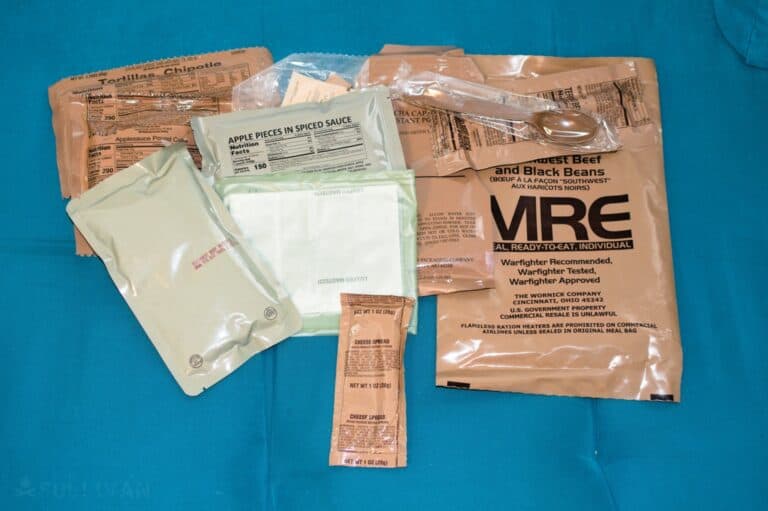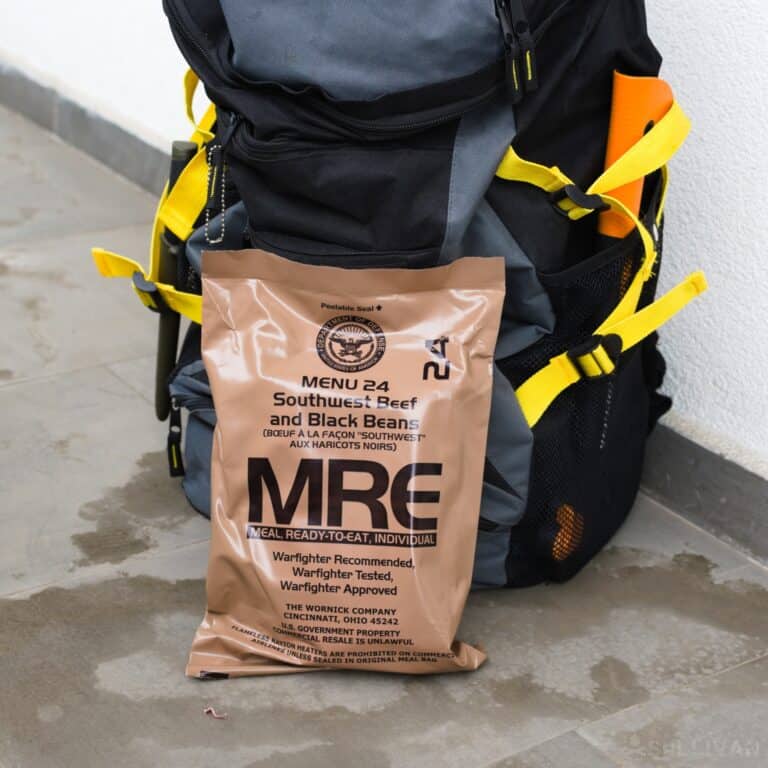Pretty much every prepper understands the value of an MRE, even if they don’t care for them. I myself know a few friends who are former military service, and they swear they would rather die than ever eat another one of these bagged meals.

However, there is no disputing that their durability, long shelf life, and calorie density makes them an attractive option for bugging out, long-term food storage, and general survival purposes.
But speaking of calories, just how many calories are in an MRE?
A typical U.S.-produced military issue MRE will contain around 1,300 calories depending on the menu selection.
That is an awful lot of calories for one complete meal, but then again the people who are typically eating them are burning a ton of calories too. But how does this calorie load factor into your own plans?
We’ll talk more about MREs and their calorie content in the rest of this article…
A Typical MRE Contains about 1,300 Calories
MREs are very calorie dense, no doubt about it, with the average menu selection for U.S. military MREs containing on average between 1,200 and 1,300 calories per meal. The calorie count in homemade MREs depends on the recipe.
This is due to the fact that these meals are designed to sustain a soldier “in the field” combat, who can burn upwards of 4,000 calories per day depending on the activity level and conditions.
As such, each MRE is packed with carbohydrates, proteins, and fats from entrees like spaghetti or beef stew along with toppings, sides, and desserts like crackers and cheese, peanut butter or jelly, candies, cookies, fruit and drink mixes.
All of these items contribute to the calorie count in an MRE, which a prepper should take into consideration when planning meals for emergency scenarios of any kind.
Calorie Load Varies with Contents
As one would expect, the actual calorie load of an MRE varies a little with the menu. For example, some MREs may have (relatively) high-calorie entrees like chili with beans or a Mexican beef wrap containing way more calories than plain chicken or most vegetarian entrees.
Likewise, the type of desserts and snacks included in the meal pouch also affects the calorie count. For example, peanut butter generally has higher calories than jelly and cookies are higher calories than fruits or other non-bakery foods.
Therefore, consider the contents of the menu when selecting pre-packaged MREs so you can make sure they fit your needs in terms of both nutrition content and caloric density.
In any case, you can still count on your average MRE containing no less than 1,150 calories.

I Thought Soldiers Were Supposed to Eat About 3,000 Calories a Day?
This is a commonly reported statistic, but one that has no basis in the operational use of MREs.
The Department of Defense has declared it good that soldiers, marines, sailors, and airmen can eat MREs for every meal when required for up to weeks at a time.
If you use the average calorie content of an MRE as a guideline, then we see our servicemen in that position would be consuming around 3,900 calories assuming they did, in fact, eat three MREs a day and ate everything in the pouch that was edible.
That is a lot of calories, and whatever the Department of Defense recommends this is not recommended for anyone that isn’t busting their ass all day, every day, in harsh conditions.
MREs from Other Nations Have Varying Calorie Levels
Another wrinkle that might affect your planning is where the MRE comes from. U.S. MREs and their civilian equivalents are the standard for most folks in the U.S., but there are MREs to be had from other nations.
In this case, consider that MREs from other countries may vary in their calorie content and the source of those calories.
For example, Polish MREs have fewer calories than U.S.-made MREs because the portions are typically smaller and menus differ.
Similarly, some Eastern European MREs contain more calories since they contain more fat and carbohydrates and less protein on average than U.S.-made offerings.
Whether this makes a difference to you for dietary reasons is one thing, but make sure to account for these caloric variations when buying in bulk if you are planning your food stores on a per-cal basis.
Civilian MREs Typically Have Fewer Calories than Military Equivalents
Another wrinkle in the MRE-calorie equation is that most civilian MREs have fewer calories than military-grade rations. Whether they have significantly less, or just a little less, depends on the brand and the offering.
Civilians have long made use of MREs for much the same reasons as the military- emergency preparedness, backpacking, camping and more.
MREs are convenient, durable, and long-lasting, so are a perfectly valid choice for any such activity.
In response to demand, many companies that produce MREs have started offering similar (not identical!) versions to civilians, with a few modifications to the contents.
This almost always results in a net reduction of calories since precious few civilians, even those working hard in the outdoors, will burn as many calories as a soldier in the field.
For example, most of the civilian-grade MREs on the market tend to top out at around 1,100 calories a meal compared to military-style offerings which can hit as high as 1,500 calories per meal in some instances.
Again, consider this when buying your emergency food stores if you are counting on accumulating ‘X’ number of calories in the form of MREs for sustenance during an emergency scenario.
The difference in total calories between military and civilian MREs spread across several cases could mean many days worth of difference!
If you are counting every calorie for your plans, contact the manufacturer for precise info.
MREs Will Keep You Alive, but are Not Healthy Long Term
And lastly, just because MREs have more than enough calories to keep you alive no matter the situation does not mean they are a complete or healthy option.
MREs are designed to be complete meals with balanced macronutrient content, but they are not nutritionally perfect.
They contain much, much more calories, fat, and sodium than the average person should consume in a day regularly.
If you plan on using MREs for an extended period of time, you will start to suffer from overconsumption of salt which can cause trouble, to say nothing of weight gain brought on by a truly tremendous amount of calories.
You only need to ask former members of the military if you want some “MRE-livin'” horror stories.
Many veterans “fondly” remember the health implications of eating them for weeks or months at a time in the form of chronic diarrhea, headaches, high-blood pressure, and crippling constipation. You have been warned.
Bottom line, plan accordingly, and don’t forget to add other nutritional sources to your emergency supplies if you plan on relying heavily on MREs for sustenance.
Be sure to account for variations in calorie content from the country of origin as well as civilian vs. military rations when planning how many packets you’ll need.
MREs are great and convenient for emergencies, but should not be the sole component of your diet, even in an emergency.

Tom Marlowe practically grew up with a gun in his hand, and has held all kinds of jobs in the gun industry: range safety, sales, instruction and consulting, Tom has the experience to help civilian shooters figure out what will work best for them.
